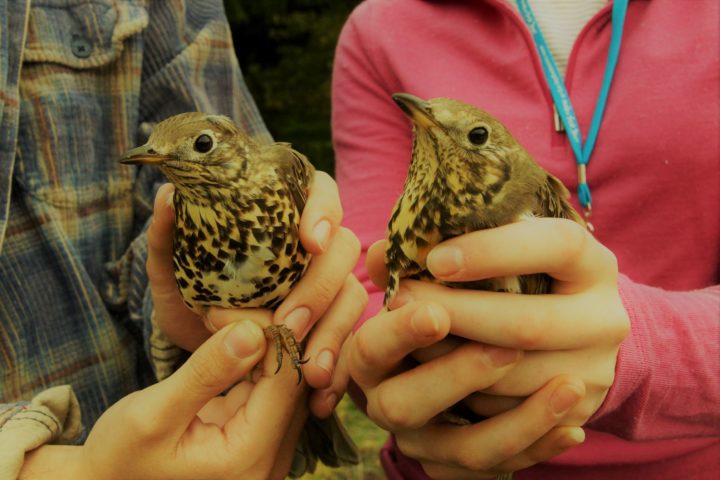Before turning to the extensive work we have been able to do at Howick this month I wanted to report that we have now been able to return to the very last Barn Owl nest of the year. Here (in an old hemmel near Craster) a pair of owls, that had already nested in another building near Howick back in June (raising 2 young) had raised a second brood after laying 5 eggs. Two had hatched and we were able to ring these on the 21st September. Its possible that there are even younger late owlets somewhere in North Northumberland but their chances of survival are now remote as we move into the winter.
At Howick adverse weather curtailed ringing early on the 6th after catching only 12 birds. Several of these were Blackcaps seen to be carrying quite a bit of ‘fat’ as a store of reserves for their migration south to the Mediterranean or North Africa (unlike other warblers they rarely cross the Sahara). The 8th proved a much better day with 29 new birds and 9 retraps processed. A young (female) Great Spotted Woodpecker was unusually well behaved as it was ringed (they usually do there very best to ‘bash’ the ringers knuckles) but the session was dominated by some of our smallest migrants, notably Chiffchaffs and Goldcrests. There were also two young Spotted Flycatchers; starting their long distance trans-Saharan migration that will take them as far as Angola. The 13th was unproductive with an annoying breeze limiting the catch to only 16 birds. Two were Chiffchaffs but the rest mostly locally resident local tits. However, the 14th was better with 23 new birds and 6 retraps. That most beautiful of birds the Long-Tailed Tit was evident with 7 captured. It is not in fact closely related to the commoner Blue and Great Tits. Its very gregarious and they even sing and call ‘to each other’ while waiting in bird bags to be processed and we try to release them in groups to help them stay together; hence the attached photograph taken just before release. We also captured two juvenile Treecreepers who often forage with tit flocks in the winter.
The 20th was a busy session with 47 new birds and 19 retraps. The retraps included a Dunnock (an Accentor) first ringed as a juvenile in 2014. We did not catch a single Blackcap, rather suggesting that all the local birds have migrated south and so any others caught will probably be birds from further north on their way south. However, there were still some Chiffchaffs along with Nuthatch, Wren, tits and Greenfinch and Chaffinch. At lunchtime we packed up the site and headed down to the Pool to try to ring this year’s swan cygnets. This we were able to do with the help of the Howick Head Gardener; who has got the swans ‘trained’ to come to grain (much better food for them than white bread). As well as the usual small metal BTO rings we also fitted larger Plastic Rings which are much easier to read and if you see any swans with such rings please report them to me (or the BTO). This year six cygnets got red rings with white letters: ZLH, ZLN, ZLR, ZLJ, ZLK, ZLL. We also checked on the condition of the adults and discovered the male (ZJP) weighed 13.25Kg, while the female (ZJX) was 9.0Kg. One of the cygnets is also heavy at 8.25Kg (probably a male). We know for certain that the female is 15 years old but we think the male is a little younger. A big thank you to everyone who helped! See attached photos of the swans just before and after they were released.

On the 21st we captured 30 new birds and 15 retraps. The new birds included six very beautiful Mistle Thrush (see attached photo). They are heavier and longer winged than Blackbirds and notable bigger than the more common ‘garden’ Song Thrush. While we do get migrant birds coming into the British Isles in the winter it seems likely these were ‘local birds’ that do form flocks at this time of year as they start to forage for food (mostly berries). The 27th was another good morning with 44 new birds and 17 retraps; including again several Mistle Thrush. There was also a good range of other species including Nuthatch (a pair), Chiffchaff, Blackcap (two carrying lots of fat), Bullfinch (another pair), a Treecreeper, Goldfinch, tits and no less than 6 Robins (suggesting that some of these may have had foreign accents!); finally there was a single Song Thrush for comparison with the larger brighter Mistle Thrush.
We continue to carry out ringing at Howick on Friday and Saturday mornings until the end of October but I suspect the weather will force us to stop at that point. I do ring in the winter but for shorter sessions and only when weather permits. If interested in ringing please get in touch.
Phil Hanmer ‘A’ Ringer/Trainer; Natural History Society of Northumbria Ringing Group (Hancock Museum).
E-mail: tytoalbas@btinternet.com